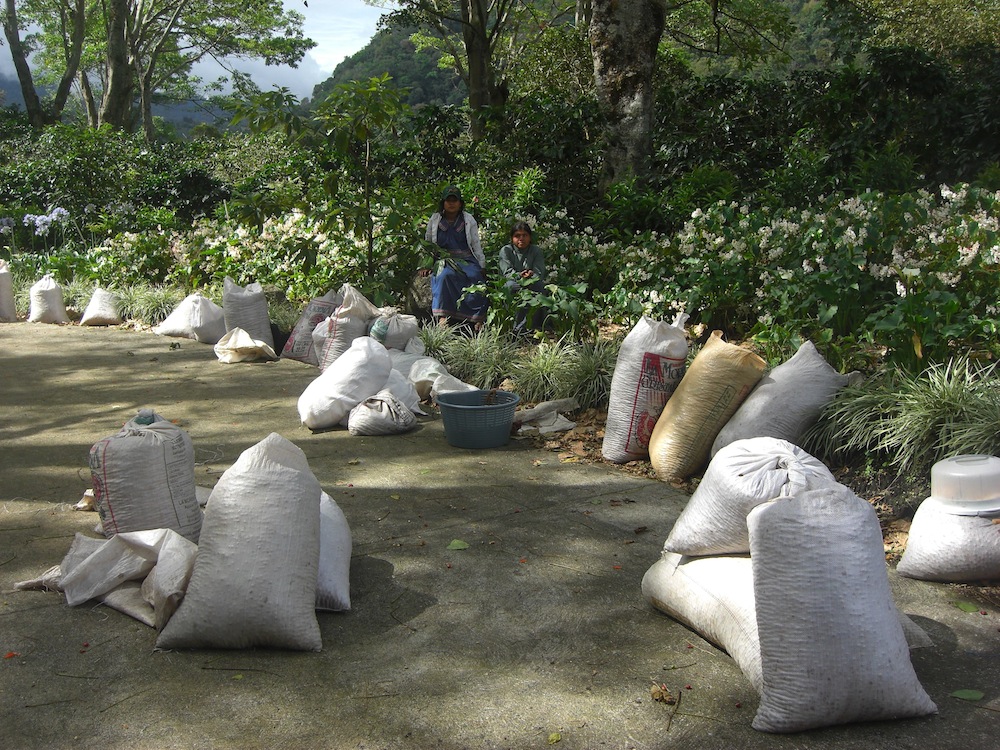Hello and Happy New Year from the highlands of Panama! I am a botanist, originally from Scotland and, these days, the farmer of a small coffee plantation in Boquete, a valley in the North of Panama by the Costa Rican border. I spend my time here growing both coffee and a sub tropical garden in the rich black soil that is to be found on the side of a 11,000 ft volcano, Volcan Baru. As it is harvest time here in Panama, I’d like to shed some light on the coffee harvesting process in our part of the world, but first a bit about my migration from Scotland to Panama.
From Corporate Worker to Coffee Farmer
My journey in coffee has not been a deliberate one. As the saying goes: Life can only be understood backwards, but it must be lived. My passion for gardens and tasting started young. Before I could walk I crawled around the garden on a hill farm in the UK, where it rained a lot, eating flowers within reach. As I learned to use a knife and fork and got a budget of my own, I tasted better things.
During my 20 years in corporate life, involving long days and too many long nights, I started drinking coffee seriously. I got to drink coffee in airports and coffee shops all over the world. When I was not on the road, my garden was my sanctuary. One day, I landed in Panama in the mountains where, as in the UK, it rains a lot, but here flowers bloom all year long and coffee grows on trees. It was like coming home only better. I am now a coffee farmer on a small hill farm where I grow coffee and flowers. The coffee ends up all around the world while the flowers stay with me on the farm.
I am on a mission to share insights from my life as a coffee farmer and to be a voice for producers. Not many small coffee farmers have the opportunity to write for a website such as CoffeeGeek. Most small coffee farmers do not have Internet connections or nor do they own computers or possess the ability to write in English. My objective is to promote a greater understanding and transparency about life at origin: the people, the plants, the weather and how it all comes together, or not, to produce high quality beans.
The Harvest
The start of the year is a great time to start sharing with you how your coffee is cultivated, harvested and processed at origin. January is an exciting time for a coffee farmer: The harvest is well underway and this time is the highlight of the farming year. The coffee harvest runs approximately from October through February here in Panama. In general, higher altitude farms with colder, wetter climates have later harvests.

January is a month where the seasons are changing. We move from the rainy to the dry season, which is known as the summer down here in the tropics. This means swapping the plastic raincoats and umbrellas for sun hats with strings to anchor them onto your head in the blustery winds, and wearing lots and lots of sunscreen. The UV levels up here in the Mountains are very high on clear sunny summer days.
Even in the summer we have rain, especially in the greener and better coffee growing areas, but the rain is a very fine mist-like spray. This is a big contrast from the torrential storms of the rainy season that can cause mud slides and flooding of the rivers. Less rain and more sunshine also bring out the summer flowers and hundreds of butterflies. It is an uplifting time for a coffee farmer.
One of the trees flowering now is the red Erythrina. Its red flowers are quite stunning against the blue sky and they are buzzing with humming birds way up there above the coffee. Erythrina is a popular shade tree for coffee as it is a leguminous, nitrogen fixing tree that improves the soils.
Fundamentally, from a coffee growing point of view, this time of year means a change from rain that swells the cherries to sunshine that ripens and dries the coffee. The summer brings great weather that ripens up the last of the harvest. We are already getting many clear, sunny, windy, dry days.
Most small coffee farms sell their harvest as red cherries for two main reasons, both money driven. Most small farmers need the cash to pay the pickers so it is a cash flow thing. Also, most small coffee farmers live on the land. They live week to week, no savings. The other reason is that in order to process the ripe cherries to green beans, in any quantity, the machinery is very expensive. To afford such a fixed cost, farms must be huge and get the economies of scale. Even then some sizable farms have gone out of business by over investing and borrowing money for coffee processing machinery. Small farms cannot even dream of being able to afford this investment, instead they have to rent machinery. Here they are hostage to the high rental fees charged by the larger players who own the equipment. Currently the costs of processing to green beans means that profit margins are the same as for selling at the cherry stage. Given that processing to green is more time consuming, most sell at the cherry stage.
For those brave souls that do wash and dry their own coffee, the weather is starting to co-operate. The strong winds have started to arrive out of the North – El Norte as the locals say. The nights in particular have been very blustery and it is not unusual to have to clear branches from fallen shade trees and banana stands from the driveway in the morning before we can get out of the farm. We are not using the de-humidifier in the house so much now. Outside relative humidity is around 70% or lower, compared to close to 100 % a month ago. This drier environment is necessary to dry the coffee cherries outside in the sun.
The humidity and rain levels can cause problems depending upon drying method for the coffee. Some farms use mechanical drum dryers. This is the safest way to do things especially when it is humid and rainy outside. Most of the machine dryers, however, are quite large, not suitable for small farms and are expensive. Most small farmers cannot afford to dry this way. If drying coffee gets wet, it takes on some funky flavors – think fermenting grass. This flavor is caused by fungus. Many smaller farms that process coffee use an African bed system where the coffee dries out in the sun on racks and is moved under cover when it rains. This process can yield some lovely flavors, arguably some of the best, but it must be done just right.
So far, it has been a significantly better harvest than last year in terms of volume. On my farm, I have already surpassed last year’s volume and I still have approximately three more picking rounds. A picking round for me lasts takes a little over a week with a team of pickers and we do another round every 10-15 days depending upon the amount of sunshine and how fast the cherries are ripening.
Asking around, most farms are doing much better in terms of yield than last year. Even the price for the red cherries at the beneficios in town has dropped by over a dollar as concern over meeting demand lessens. A beneficio is a coffee processing plant where the coffee cherries are delivered and sold every day before being taken for sorting, washing, drying and classification.
In October we farmers were getting well over $10 now it is down to $9 for a lata. A lata is a measure of cherries. We use an old white plastic tub to measure out a lata. At the end of a picking day we note down how many latas each picker took by taking their sacks of coffee and pouring them into the lata measure then placing those cherries into another sack. They are paid based upon volume and this year they have been paid $3 per lata. A lata works out at approximately 30lbs of red cherries. Pickers speed and capacity to pick a lata varies. If I pick a lata it takes me all morning. An experienced coffee picker can work much faster and get around 6-8 latas in an 8 hour day.
Last year was extremely wet across Central America. This caused the cherries to split and fall before they could all be picked. Volumes were down significantly for most farms. This year we have had relatively warm drier weather. The biggest issue for us seems to have been leaf rust fungus, which thrives in the dry, warmer weather. The leaf rust fungus causes the bushes to drop their leaves – no leaves means no energy factory to swell and ripen the cherries. As there are many microclimates in the Valley, different farms have been affected to differing degrees. I have had to fumigate with fungicide several times this season to protect the coffee trees from leaf rust. We cannot fumigate when we are picking so it is a tricky business balancing the treatment and harvest.
The harvest is an intense season. We farmers here in Panama, like all coffee farmers, are very much at the mercy of the weather. A factor we have no control over. Farming makes you philosophical or crazy depending. It is a daily reminder of how small we are in the bigger scheme of things and how utterly dependent on Mother Nature we are.


What’s to Come
Over the coming months I am looking forward to sharing more of my life and learnings as a coffee farmer. In my next couple of columns we will talk about coffee picking. First, why getting buckets of those red ripe cherries is much harder than it sounds. Then the when, what and how of coffee picking. I am also looking forward to explaining more about our coffee pickers: The wonderful and little understood Indigenous tribe of Ngobe Indians who live in the North of Panama and do the hard work of getting those cherries off the trees. For now it’s back to the harvest for me!























